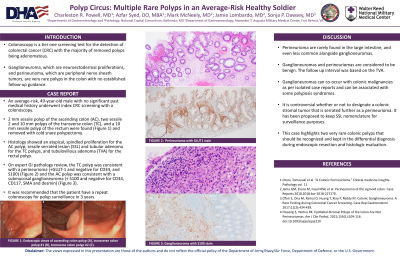Monday Poster Session
Category: Colon
P1669 - Polyp Circus: Multiple Rare Polyps in an Average-Risk Healthy Soldier
Monday, October 23, 2023
10:30 AM - 4:15 PM PT
Location: Exhibit Hall

Has Audio
- CP
Charleston R. Powell, MD
Walter Reed National Military Medical Center
Bethesda, MD
Presenting Author(s)
Charleston R. Powell, MD1, Azfar S.. Syed, DO, MBA1, Sonja P. Dawsey, MD2
1Walter Reed National Military Medical Center, Bethesda, MD; 2Fort Belvoir Community Hospital, Fort Belvoir, VA
Introduction: Colonoscopy is a tier one screening test for the detection of colorectal cancer (CRC) that allows for the removal and evaluation of suspicious polyps. Typical colonoscopy intervals are based on polyp size, histological type, and quantity with the majority of removed polyps being adenomatous on histology. Ganglioneuroma, which are neuroectodermal proliferations, and perineurioma, which are peripheral nerve sheath tumors, are very rare polyps in the colon with no established follow-up guidance in the literature. Here. we present a case of these two rare polyp types being found in the same patient along with an advanced polyp.
Case Description/Methods: An average-risk, 49-year-old male with no significant past medical history underwent CRC screening with an index colonoscopy. A 2 mm sessile polyp of the ascending colon (AC), two sessile 2 and 10 mm polyps of the transverse colon (TC), and a 10 mm sessile polyp of the rectum were found (Figure 1) and removed with cold snare polypectomy. The remainder of the examination was normal.
Histology showed an atypical, spindled proliferation for the AC polyp, sessile serrated lesion (SSL) and tubular adenoma for the TC polyps, and tubulovillous adenoma (TVA) for the rectal polyp. However, on expert GI pathology review, the AC polyp was consistent with a submucosal ganglioneuroma (+ S100 and negative for CD34, CD117, SMA and desmin) and the SSL with a perineurioma (+GLUT-1 and negative for CD34, and S100). It was recommended that the patient have a repeat colonoscopy for polyp surveillance in 3 years.
Discussion: Perineurioma are rarely found in the large intestine, with only a handful of cases reporting them in the TC. Even less common are reports of them being found alongside ganglioneuromas, which are also very rare in the colon. Given the presence of the TVA, a high-risk lesion, it was easy to determine a follow-up surveillance interval, especially since ganglioneuromas and perineuriomas are considered to be benign. Ganglioneuromas can co-occur with colonic malignancies as per isolated case reports and can be associated with some polyposis syndromes. It is controversial whether or not to designate a colonic stromal tumor that is serrated further as a perineurioma. It has been proposed to keep SSL nomenclature for surveillance purposes. This case highlights two very rare colonic polyps that should be recognized and kept in the differential diagnosis during endoscopic resection and histologic evaluation.

Disclosures:
Charleston R. Powell, MD1, Azfar S.. Syed, DO, MBA1, Sonja P. Dawsey, MD2. P1669 - Polyp Circus: Multiple Rare Polyps in an Average-Risk Healthy Soldier, ACG 2023 Annual Scientific Meeting Abstracts. Vancouver, BC, Canada: American College of Gastroenterology.
1Walter Reed National Military Medical Center, Bethesda, MD; 2Fort Belvoir Community Hospital, Fort Belvoir, VA
Introduction: Colonoscopy is a tier one screening test for the detection of colorectal cancer (CRC) that allows for the removal and evaluation of suspicious polyps. Typical colonoscopy intervals are based on polyp size, histological type, and quantity with the majority of removed polyps being adenomatous on histology. Ganglioneuroma, which are neuroectodermal proliferations, and perineurioma, which are peripheral nerve sheath tumors, are very rare polyps in the colon with no established follow-up guidance in the literature. Here. we present a case of these two rare polyp types being found in the same patient along with an advanced polyp.
Case Description/Methods: An average-risk, 49-year-old male with no significant past medical history underwent CRC screening with an index colonoscopy. A 2 mm sessile polyp of the ascending colon (AC), two sessile 2 and 10 mm polyps of the transverse colon (TC), and a 10 mm sessile polyp of the rectum were found (Figure 1) and removed with cold snare polypectomy. The remainder of the examination was normal.
Histology showed an atypical, spindled proliferation for the AC polyp, sessile serrated lesion (SSL) and tubular adenoma for the TC polyps, and tubulovillous adenoma (TVA) for the rectal polyp. However, on expert GI pathology review, the AC polyp was consistent with a submucosal ganglioneuroma (+ S100 and negative for CD34, CD117, SMA and desmin) and the SSL with a perineurioma (+GLUT-1 and negative for CD34, and S100). It was recommended that the patient have a repeat colonoscopy for polyp surveillance in 3 years.
Discussion: Perineurioma are rarely found in the large intestine, with only a handful of cases reporting them in the TC. Even less common are reports of them being found alongside ganglioneuromas, which are also very rare in the colon. Given the presence of the TVA, a high-risk lesion, it was easy to determine a follow-up surveillance interval, especially since ganglioneuromas and perineuriomas are considered to be benign. Ganglioneuromas can co-occur with colonic malignancies as per isolated case reports and can be associated with some polyposis syndromes. It is controversial whether or not to designate a colonic stromal tumor that is serrated further as a perineurioma. It has been proposed to keep SSL nomenclature for surveillance purposes. This case highlights two very rare colonic polyps that should be recognized and kept in the differential diagnosis during endoscopic resection and histologic evaluation.

Figure: FIGURE 1: Endoscopic views of 2 mm polyp of ascending colon (A), 10 mm polyp of the transverse colon (C), and 2 mm polyp of the transverse colon.
Disclosures:
Charleston Powell indicated no relevant financial relationships.
Azfar Syed indicated no relevant financial relationships.
Sonja Dawsey indicated no relevant financial relationships.
Charleston R. Powell, MD1, Azfar S.. Syed, DO, MBA1, Sonja P. Dawsey, MD2. P1669 - Polyp Circus: Multiple Rare Polyps in an Average-Risk Healthy Soldier, ACG 2023 Annual Scientific Meeting Abstracts. Vancouver, BC, Canada: American College of Gastroenterology.
